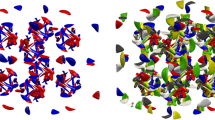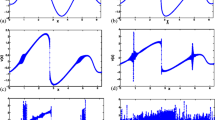Abstract
We compare the predictions of stochastic closure theory (SCT) (Birnir in J Nonlinear Sci 23:657–688, 2013a. https://doi.org/10.1007/s00332-012-9164-z) with experimental measurements of homogeneous turbulence made in the variable density turbulence tunnel (Bodenschatz et al. in Rev Sci Instrum 85(9):093908, 2014) at the Max Planck Institute for Dynamics and Self-Organization in Göttingen. While the general form of SCT contains infinitely many free parameters, the data permit us to reduce the number to seven, only three of which are active over the entire range of Taylor–Reynolds numbers. Of these three, one parameter characterizes the variance of the mean-field noise in SCT and another characterizes the rate in the large deviations of the mean. The third parameter is the decay exponent of the Fourier variables in the Fourier expansion of the noise, which characterizes the smoothness of the turbulent velocity. SCT compares favorably with velocity structure functions measured in the experiment. We considered even-order structure functions ranging in order from two to eight as well as the third-order structure functions at five Taylor–Reynolds numbers (\(R_\lambda \)) between 110 and 1450. The comparisons highlight several advantages of the SCT, which include explicit predictions for the structure functions at any scale and for any Reynolds number. We observed that finite-\(R_\lambda \) corrections, for instance, are important even at the highest Reynolds numbers produced in the experiments. SCT gives us the correct basis function to express all the moments of the velocity differences in turbulence in Fourier space. These turn out to be powers of the sine function indexed by the wavenumbers. Here, the power of the sine function is the same as the order of the moment of the velocity differences (structure functions). The SCT produces the coefficients of the series and so determines the statistical quantities that characterize the small scales in turbulence. It also characterizes the random force acting on the fluid in the stochastic Navier–Stokes equation, as described in this paper.

















Similar content being viewed by others
References
Anderson Jr., J.D.: A History of Aerodynamics: and Its Impact on Flying Machines, vol. 8. Cambridge University Press, Cambridge (1999)
Baals, D.D., Corliss, W.R.: Wind Tunnels of NASA, vol. 440. National Aeronautics and Space Administration, Scientific and Technical Information Branch, Washington, D.C. (1981)
Barndorff-Nilsen, O.E.: Exponentially decreasing distributions for the logarithm of the particle size. Proc. R. Soc. Lond. A 353, 401–419 (1977)
Bernard, P.S., Wallace, J.M.: Turbulent Flow. Wiley, Hoboken (2002)
Bhattacharya, R., Waymire, E.C.: Stochastic Processes with Application. Wiley, New York (1990)
Birnir, B.: The Kolmogorov–Obukhov statistical theory of turbulence. J. Nonlinear Sci. 23, 657–688 (2013a). https://doi.org/10.1007/s00332-012-9164-z
Birnir, B.: The Kolmogorov–Obukhov Theory of Turbulence. Springer, New York (2013b)
Birnir, B.: From Wind-Blown Sand to Turbulence and Back, pp. 15–27. Springer, Cham (2016)
Blum, D.B., Bewley, G.P., Bodenschatz, E., Gibert, M., Gylfason, A., Mydlarski, L., Voth, G.A., Xu, H., Yeung, P.K.: Signatures of non-universal large scales in conditional structure functions from various turbulent flows. New J. Phys. 13, 113020 (2011)
Bodenschatz, E., Bewley, G.P., Nobach, H., Sinhuber, M., Xu, H.: Variable density turbulence tunnel facility. Rev. Sci. Instrum. 85(9), 093908 (2014)
Comte-Bellot, G., Corrsin, S.: The use of a contraction to improve the isotropy of grid-generated turbulence. J. Fluid Mech. 25(04), 657–682 (1966)
Corrsin, S.: Turbulent flow. Am. Sci. 49(3), 300–325 (1961)
Da Prato, G., Zabczyk, J.: Encyclopedia of Mathematics and Its Applications: Stochastic Equations in Infinite Dimensions. Cambridge University Press, Cambridge (2014)
Dubrulle, B.: Intermittency in fully developed turbulence: in log-Poisson statistics and generalized scale covariance. Phys. Rev. Lett. 73(7), 959–962 (1994)
Grimmett, G., Stirzaker, D.: Probability and Random Processes. Oxford University Press, Oxford (2001)
Hunt, B.R., Sauer, T., Yorke, J.A.: Prevalence: a translation-invariant almost every on infinite-dimensional spaces. Bull. Am. Math. Soc. 27(2), 217–238 (1992)
Kolmogorov, A.N.: Dissipation of energy under locally isotropic turbulence. Dokl. Akad. Nauk SSSR 32, 16–18 (1941a)
Kolmogorov, A.N.: The local structure of turbulence in incompressible viscous fluid for very large Reynolds number. Dokl. Akad. Nauk SSSR 30, 9–13 (1941b)
Kolmogorov, A.N.: A refinement of previous hypotheses concerning the local structure of turbulence in a viscous incompressible fluid at high Reynolds number. J. Fluid Mech. 13, 82–85 (1962)
Landau, L.D., Lifshits, E.M.: Fluid Mechanics: Transl. from the Russian by JB Sykes and WH Reid. Addison-Wesley, New York (1959)
Millikan, C.B., Smith, J.E., Bell, R.W.: High-speed testing in the Southern California cooperative wind tunnel. J. Aeronaut. Sci. 15(2), 69–88 (1948)
Oksendal, B.: Stochastic Differential Equations. Springer, New York (1998)
Pope, S.B.: Turbulent Flows. Cambridge University Press, Cambridge (2000)
Prandtl, L.: Göttingen wind tunnel for testing aircraft models. National Advisory Committee for Aeronautics, Washington, DC (1920)
Reynolds, O.: On the dynamical theory of incompressible viscous fluids and the determination of the criterion. Philos. Trans. R. Soc. Lond. 186A, 123–164 (1885)
She, Z.-S., Leveque, E.: Universal scaling laws in fully developed turbulence. Phys. Rev. Lett. 72(3), 336–339 (1994)
She, Z.-S., Waymire, E.: Quantized energy cascade and log-Poisson statistics in fully developed turbulence. Phys. Rev. Lett. 74(2), 262–265 (1995)
Sinhuber, M., Bewley, G.P., Bodenschatz, E.: Dissipative effects on inertial-range statistics at high Reynolds numbers. Phys. Rev. Lett. 119, 134502 (2017)
Sinhuber, M., Bodenschatz, E., Bewley, G.P.: Decay of turbulence at high Reynolds numbers. Phys. Rev. Lett. 114, 034501 (2015)
Taylor, G.I.: Statistical theory of turbulence. Proc. R. Soc. Lond. 151, 421–444 (1935)
Vallikivi, M., Smits, A.J.: Fabrication and characterization of a novel nanoscale thermal anemometry probe. J. Microelctromech. Syst. 23(4), 899–907 (2014)
Walsh, J.B.: An introduction to stochastic differential equations. In: Dold, A., Eckmann, B. (eds.) Springer Lecture Notes. Springer, New York (1984)
Acknowledgements
The experimental data presented in this paper were taken during the doctoral studies of Michael Sinhuber, group leader/postdoc during the time of Greg Bewley and time of John Kaminsky at the Max Planck Institute for Dynamics and Self-Organization. We are grateful to Eberhard Bodenschatz for fruitful discussions and the possibility to utilize the data.
Author information
Authors and Affiliations
Corresponding author
Additional information
Communicated by Charles R. Doering.
Publisher's Note
Springer Nature remains neutral with regard to jurisdictional claims in published maps and institutional affiliations.
Rights and permissions
About this article
Cite this article
Kaminsky, J., Birnir, B., Bewley, G.P. et al. Reynolds Number Dependence of the Structure Functions in Homogeneous Turbulence. J Nonlinear Sci 30, 1081–1114 (2020). https://doi.org/10.1007/s00332-019-09602-y
Received:
Accepted:
Published:
Issue Date:
DOI: https://doi.org/10.1007/s00332-019-09602-y




